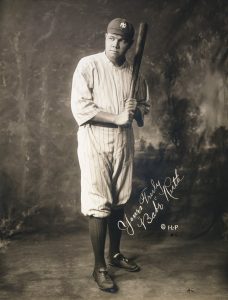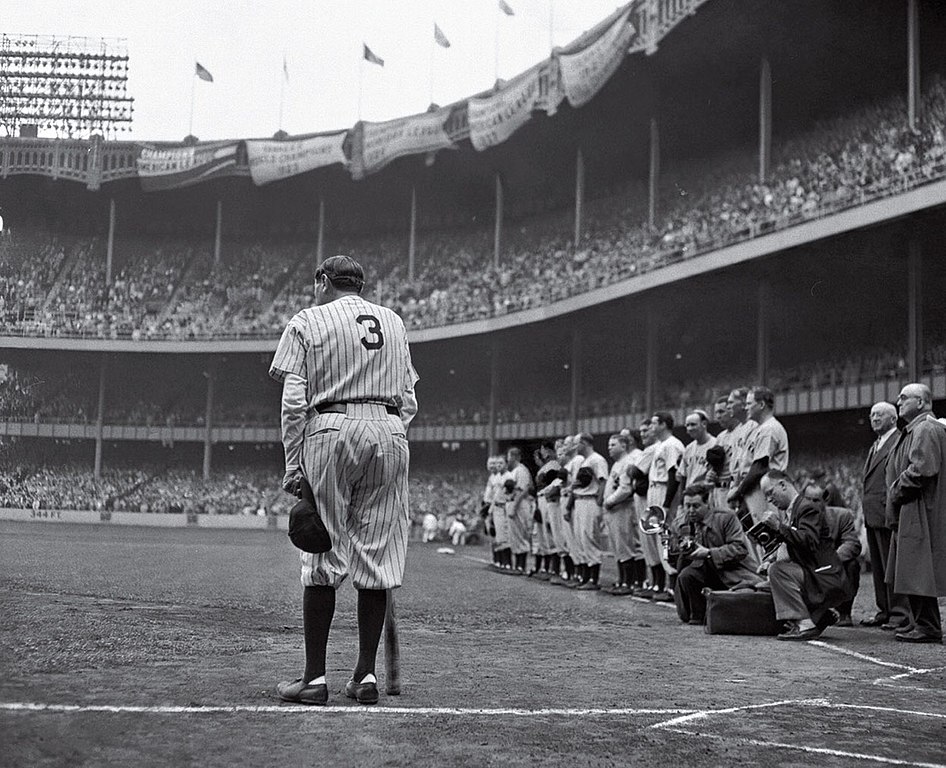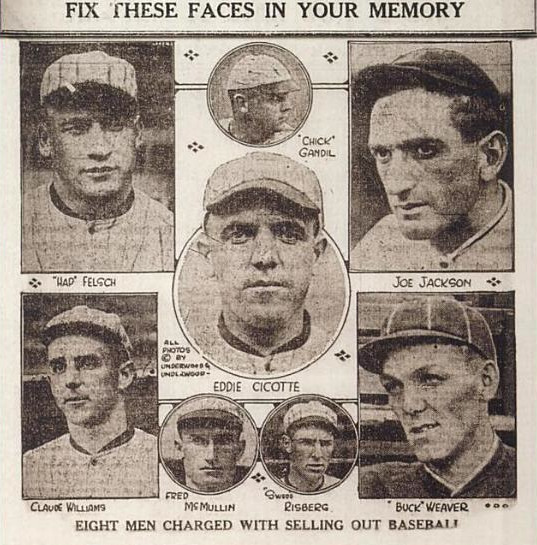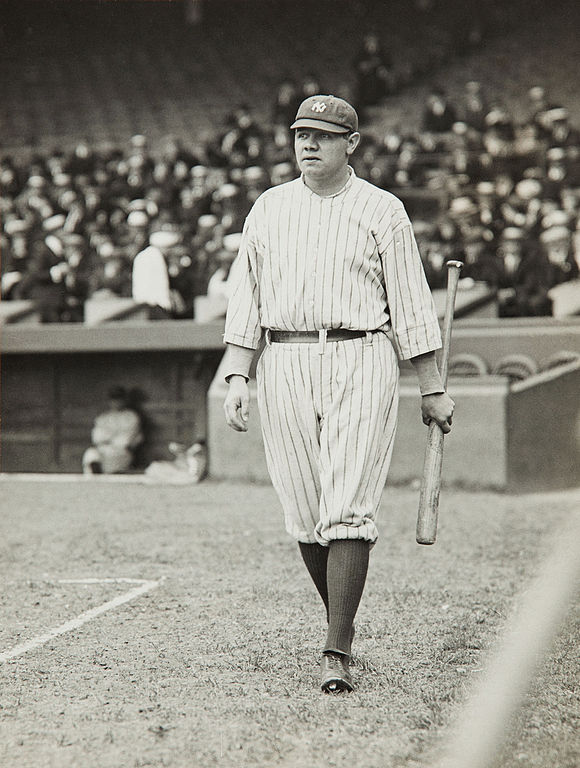
Original Author: Irwin, La Broad, & Pudlin
U.S. Library of Congress digital id#cph.3g07246
Public Domain
In the annals of baseball, Babe Ruth is considered one of the greatest sluggers of all time. Called “the Bambino”, the “Sultan of Swat”, or just Babe Ruth, his name is etched forever in baseball history. His professional career spans 22 seasons from 1914-1935. Starting out as a left-handed pitcher for the Boston Red Sox, Babe Ruth showed he had a talent as a slugger hitting an impressive. 29 homeruns for the Red Sox in 1919. That beat the record of 24 set in 1884 by Ned Williamson of the Chicago White Sox. Under the Red Sox, he was in three World Series including the one in 1919. Boston fans were thrilled with the Babe, but the team owner Harry Frazee, needing cash for his theatre, decided to sell the champion team to raise cash. Babe Ruth was traded to the New York Yankees. The Boston Red Sox would not win another World Series until 2004. During that long drought, it was called the Curse of the Bambino.
Baseball suffered a major crisis over the Black Sox Scandal. The 1919 World Series between the Chicago White Sox and the Cincinnati Reds was tainted by allegations that eight members of the Sox were paid to lose by a gambling syndicate. Evidence was presented to a grand jury and they indicted the 8 players. Key evidence disappeared and signed confessions of two players were recanted. The trial ended up in an acquittal but the new commissioner of baseball, former federal judge Kenesaw Mountain Landis, banned all eight from baseball for life. America was stunned by the conduct of the 8 players. While Landis brought the hammer down to clean up baseball, the game needed a reboot for people had turned away from the game.
And it was in New York where a former pitcher, now outfielder, and who could swing a bat like no one else had seen before, would make baseball once again popular for people to pay to see. Crowds would come to see this slugger, with the impossibly shaped body, send balls out of the park. Attendance figures soared for the Yankees. And the home runs would continue to come but the old Polo Grounds, where both the New York Giants and Yankees called home, was a problem. There were tensions between the teams and the Polo Grounds owner decided not to renew the Yankees lease. The Yankees would build their own stadium in the Bronx which opened in 1923. The stadium was designed to accommodate Ruth to make it easier for the lefthanded batter to hit home runs. He would end that year with 41 home runs and the Yankees would win the title. Yankee Stadium would be called later the “House that Ruth Built.”
He would continue to play with the Yankees until 1934. By then age had begun to take its toll on his skills. He also was well known for his excessive drinking, food binges, and frequently cheating on his wife Helen, who he had married in 1914. They were not seen together often, and the last time was during the 1926 World Series. Since both were Catholic, they never divorced but did separate and lived separate lives until her death in 1929. She was living with a dentist Edward Kinder, and everyone assumed she was his wife. Her death caused headlines. At her funeral, the Babe was seen sobbing. He would later marry Claire Merritt Hodgson, an actress and model. She would impose on him structure which curbed his notorious drinking, binging, and adulterous behavior.
Ruth had hoped to become a team manager in his twilight years; he wanted to be the Yankees manager. However, that was not to be. He was offered by the team owner to manage the Yankees minor league team, but he turned that down. Finally, the Boston Braves, in desperate need to improve attendance, would get Ruth. He was traded to the Boston Braves not as a player but to become team vice-president and assistant manager to its skipper Bill McKechnie. The trade was concluded on 26 February 1935. However, his declining skills showed up in playing. And it turned out his vice president position was nothing more than doing public relations for the team. He also realized that Boston Braves owner Emil Fuchs was not going to make him manager. And that he was supposed to invest some of his own money in the team. He asked to be let go but was persuaded to stay on until after Memorial Day.
And it was on 25 May 1935 Babe Ruth would make the last home run of his career. It was the third game of the series between the Boston Braves and the Chicago Cubs. He would hit a soaring home run that went out of Forbes Field. It sailed over the right field upper deck and out of the park. It was the first time anyone had hit a fair ball out of the park in that area. Ruth was urged to end his career right then, but he had given his word and so went to Cincinnati and Philadelphia. His final appearance in Major League Baseball was in Philadelphia. It was a doubleheader, and the Braves lost both. He retired on 2 June 1935. The Braves had the lowest winning percentage in National League history. The team was broke and so was its owner. The Braves would be handed over to the National League to find new owners.
Ruth wanted to manage a team but that would never come. His wife said he would sit by the phone waiting for a call. Of all the players who were the first inductees to the Baseball Hall of Fame in 1936, he was the only one not asked to manage a major league baseball team. Many attributed this to his days when he was drinking and was not always keen on being disciplined as a reason. Whatever the reason, Ruth would never manage or play for a team again. He would continue to be seen in public playing golf and some exhibition games. His next major appearance though was on 4 July 1939 for Lou Gehrig Appreciation Day. The 1927 Yankees team assembled to honor the great first baseman who was forced into retirement when he contracted ALS or often called today, Lou Gehrig’s Disease. Ruth appeared in the 1942 film The Pride of the Yankees as himself. During World War II he made many personal appearances to support the war effort.
In 1946 Ruth was diagnosed with an inoperable tumor at the base of his skull. Because of his fame and wealth, he was able to get treatment and even access to experimental treatments. Taking both drugs and radiation treatments, Ruth hoped it would allow him to live more years. On 27 April 1947 it was Babe Ruth Day as declared by the new commissioner of baseball Happy Chandler. Ruth attended and many of his former teammates were there to speak in his honor. By then his usual load voice had been turned into a soft whisper by the cancer. He would next appear at Yankee Stadium on 13 June 1948 for the 25th-anniversary celebration of Yankee Stadium-the House that Ruth built. He was visibly different looking thin and using a bat as a cane. The photo taken of him by Nat Fein of him standing near home plate, leaning on the cane, and looking out to what is dubbed “Ruthville” became etched in the minds of millions who saw the photo. And it would win a Pulitzer Prize for Fein.

Author: Nathaniel Fein
Public Domain via Wikimedia Commons
On 16 August 1948 at 8:01 PM, the Babe, born George Herman Ruth, would pass away at age 53. Many were already outside the hospital during his final days. And his death came quietly as he died in his sleep. Memorial celebrations took three days. His body was taken to the rotunda of Yankee Stadium and visitors could view the Sultan of Swing one last time in his open casket. It would stay there for 2 days. Between 77,000-100,00 are believed to have past the casket. His funeral mass was celebrated by Francis Cardinal Spellman at St. Patrick’s Cathedral. The cathedral was packed and an even larger crowd outside estimated to be around 75,000. He was buried at Gate of Heaven Cemetery in Hawthorne, New York. His second wife is interred next to him.
A granite memorial to Babe Ruth was unveiled on 19 April 1949 near to where similar tributes were erected for Lou Gehrig and Miller Huggins. Due to remodeling between 1974-1975, the area was enclosed and after that became known as Monument Park. When the new Yankee Stadium opened in 2008, Monument Park was moved to the new stadium but unlike the old stadium, not seen from the field. Spectators can visit this area up to 45 minutes before first pitch. His birthplace in Baltimore has been renovated and is now the Babe Ruth Birthplace and Museum.
Ruth’s contribution to baseball was significant. World War I, the Spanish Flu epidemic, and the Black Sox Scandal all contributed to a sour mood in the early 1920’s. And then this larger-than-life figure appears. Unlike Ty Cobb, who was almost always in a sour mood and not always having good relations with fans, Ruth came across as something completely different. He could swing the bat like no other, flamboyant and flashy, totally unstoppable. He became not just the Yankee’s best hitter, bunter, and base stealer but a symbol when people needed to take their minds off from other things. Seeing Ruth hit a home run was a joyous event where thousands cheered. He transcended the sport and became an icon. Home runs were no longer rare but expected. In the old days home runs were rare, but no more.
Ruth also was an American success story having come up from without any advantage of wealth or social standing. You didn’t need to come from wealth to play ball, you just needed the skill to play the game well. And many young kids would make it a dream to head for a baseball team so they too could be a success like Ruth, Gehring and so many others. In a time when most never saw him play, they read the stories of his feats in the newspapers or heard it on the radio once stations started carrying baseball games. And perhaps one of the strangest-and perhaps sweetest ways-he is remembered is the Baby Ruth candy bar. Marketed originally by Curtis Candy Company and named for the daughter of Grover Cleveland, it came out in 1921 and so many assumed it was named for the famous ball player. In 1995 though the Ruth estate (which manages all licensing of Babe Ruth products and images) licensed his likeness for the candy bar. It became the official candy of Major League Baseball in 2005. And in 2018, President Donald Trump awarded Babe Ruth (posthumously) the Presidential Medal of Freedom.
Sources
Admin, W. (2024, July 3). Home. Babe Ruth. https://baberuth.com/
Admin. (2022, October 21). Babe Ruth. https://sabr.org/bioproj/person/babe-ruth/
Babe Ruth Birthplace Sports Legends Museum Baltimore MD. (2020, March 19). Babe Ruth Birthplace Museum Baltimore MD. https://baberuthmuseum.org/
Babe Ruth stats, height, weight, position, rookie status & more | Baseball-Reference.com. (n.d.). Baseball-Reference.com. https://www.baseball-reference.com/players/r/ruthba01.shtml
Ruth, Babe | Baseball Hall of Fame. (n.d.). https://baseballhall.org/hall-of-famers/ruth-babe
Rader, B. G. (2024, August 14). Babe Ruth | Biography, Stats, nicknames, & Facts. Encyclopedia Britannica. https://www.britannica.com/biography/Babe-Ruth
Wikipedia contributors. (2024f, August 14). Babe Ruth. Wikipedia. https://en.wikipedia.org/wiki/Babe_Ruth#
Suggested Reading
Leavy, J. (2019). The Big Fella: Babe Ruth and the World He Created. Harper Perennial.
Pirone, D. R., & Martens, C. (1988). My Dad the Babe: Growing Up with an American Hero. Quinlan Press (MA).
Ruth, B., & Considine, B. (1992). The Babe Ruth Story. Signet.
Ruth, B., Cobb, W. R., & Dickson, P. (2011). Playing the game: My Early Years in Baseball. Courier Corporation.
Stanton, T. (2008). Ty and The Babe: Baseball’s Fiercest Rivals: A Surprising Friendship and the 1941 Has-Beens Golf Championship. St. Martin’s Griffin.
Titanic News Channel is a participant in the Amazon Services LLC Associates Program, an affiliate advertising program designed to provide a means for sites to earn advertising fees by advertising and linking to Amazon.com.






